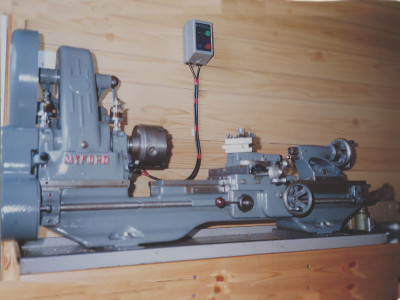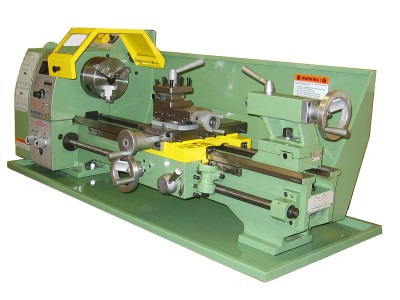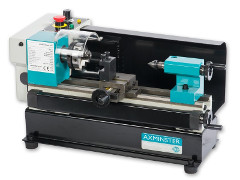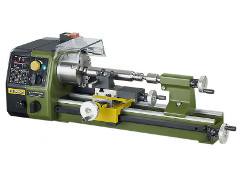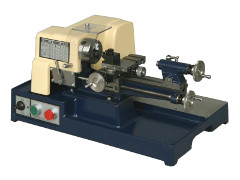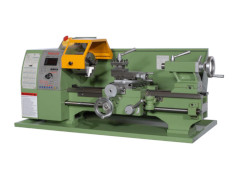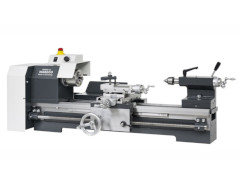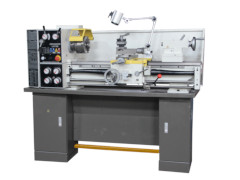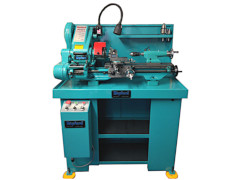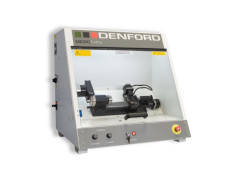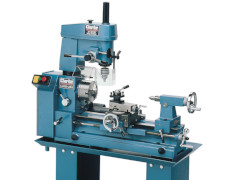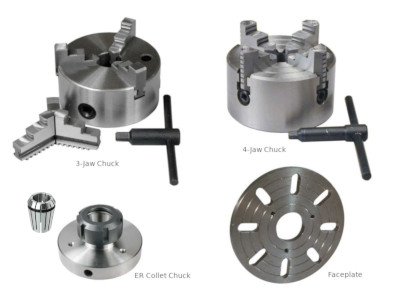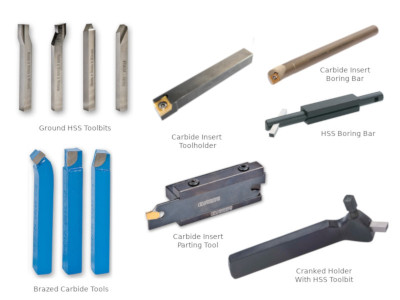Getting Started In Model Engineering
Workshop Machinery - Introduction
Now that the new workshop is coming along nicely it is time to think about some machinery to make work that bit easier. This will likely be expensive so worthwhile doing some research and making sure that your lathe and milling machine will do what you want of them. When I first set up my workshop it was very unusual for model engineers or hobbyists to have a milling machine but I think now it is almost a given that lathe and mill are required. It is of course still possible to use the lathe for milling operations and if space is limited combination machines are available.
The process of choosing machinery can be a bit overwhelming especially for the first time. Take it slowly, read a lot, seek advice from friends, join a club, use the internet (carefully), go to one of the few remaining exhibitions. You will end up with the right machines for you. Some things you need to consider, mainly in respect of the lathe but also for other machinery:
- What do you want to make - a clear picture of the first few projects is always useful but not necessarily easy to come by.
- Available workshop space - if it won′t fit in the space you have think again. Don′t forget access space around the machine for cleaning and maintenance. The bigger the machine the more space around it. You can move a small lathe to get at the workings but a 1tonne mill is a different matter!
- Budget - as the machinery gets bigger or better (or both) prices can head skywards at an alarming rate. Don't forget you will need accessories and consumables. These also cost more as the machine gets larger.
- Capacity - big projects require big machines but not necessarily the converse, you can make small things with big machines (within reason and suitable speed range). Tooling takes up space so factor that in. Really big machines may need lifting equipment to move chucks, vices and workpieces.
- Sophistication - purely manual, automatic feed, screw-cutting, gearbox, a turret lathe or even CNC. Good work can be done on the simplest of machines but some degree of automation can make life easier and quicker.
- Accessories - are these available/affordable for you chosen machine. Milling machines in particular will need plenty of tooling. If possible standardize so that equipment can be used on all your machinery.
- New or used - it is always nice to have something new, shiny and unsullied but there are some excellent used machines about which can offer more for your hard-earned cash.
- Local or foreign made - probably a choice between used locally made or new Chinese manufacture. New European or American machinery is available, often expensive and aimed more at industry but beware that even machines claiming to be locally made are often made in China under supplier supervision. This can be difficult to elicit from the "manufacturers" published information.
The process of buying new machinery is akin to buying a car and ultimately the choices are governed a great deal by personal preference. I won′t be recommending you buy "Brand A" or even "Brand X" but perhaps a little guidance to steer that preference.
4 - Lathes
Whatever your machine of choice, go and see it before you buy if at all possible. Twiddle the handwheels, listen to it running, open all the covers and look inside. Better yet if you can get a demonstration or even use it. Find out what comes with it and what doesn′t. Check what the power requirements are and what are the likely carriage costs. And of course if you don′t know what you are looking at try and find someone who does to go with you. If you are new to the lathe, I have put a bit of a glossary in the data & tables section.
By way of an introduction to lathes, the images above are of my own lathes, the Myford ML7 (1) which served me well for about 25 years. The Warco WM250 (2) I have had since 2007. Apart from these two I have used, albeit some many years ago, Colchester, Harrison, Kerry and others so I can tell which way is up on the lathe but definitely not an expert. Both of my lathes are in the small category, so that you can compare I have included some specifications below. Creating a table like this is a useful way of comparing two or more lathes that you might be interested in. You should probably include "cost" somewhere in the table.
| WM250 ML7 Comparison | ||
|---|---|---|
| Measurement | WM250 | ML7 |
| Swing Over Bed | 250mm (10") | 180mm or 250mm in gap |
| Distance Between Centres | 550mm (22") | 500mm |
| Spindle Taper | MT4 | MT2 |
| Spindle Bore | 26mm (1") | 15mm |
| Speeds | 50 to 2500rpm in two ranges | 32 to 640rpm 6 speeds |
| Motor | 750W (1hp) | 375W (½hp) |
| Overall Dimensions (LxWxH) | 1194x610x432mm (47x24x17") | 1042x650x520mm |
| Weight | 120kg (264lbs) | 86kg |
Between my two lathes I have covered some of the major choices when buying. The Myford was used and made in the UK. The Warco was new and made in China. Both were suitably sized both for my needs and the available space. I don′t suppose any of this has helped your choice much so a quick look at other some other possibilities.
It is probably worth mentioning here, that during your research you may well come across what might be called the "Myford Lobby". There are those, particularly model engineers, who insist that the only lathe worth having is a Myford. There is absolutely nothing wrong with a good Myford but it is worth bearing in mind that the Myford was designed some 80 years ago and has not changed substantially since. Prices in the used market are often inflated beyond reason. Some lathes have been nurtured since new but many more have been used, abused and re-sold numerous times. Whilst a "new" Myford might be a possibility, I am not sure that they actually exist despite the name having been acquired by RDG Tools. Lastly think on the fact that there are millions of lathes in the world and most of them are NOT Myford.
Mini-Lathes
Many first time buyers opt for one of the mini-lathes, they don′t cost too much so if it's not right it can be sold on and much experience of what is needed will have been gained. These small lathes don′t take up much space can be moved by one person and may well be completely sufficient for your needs. There is also plenty of information on the interweb on choosing, using and modifying them. There are a couple of books on the mini-lathe in the further reading list at the end of this page which may be of interest.
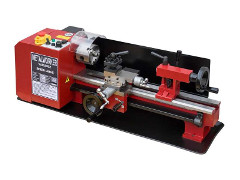
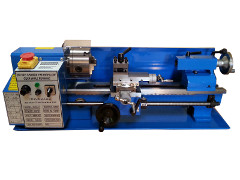
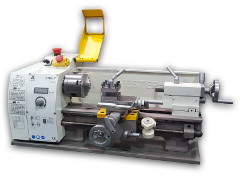
Click On Image To Magnify
You can get a mini-lathe in pretty much any colour you like although I have yet to see a pink one! There are plenty of suppliers in the UK but as far as I can make out just three main (common) manufacturers. Sieg (3) probably most common, Real Bull (4) now called Yangzhou Qion Niu Machine Tool Company Ltd and Weiss (5) who tend towards making much larger machines, this is their smallest. There are probably more makers out there but Chinese manufacturers seem a little shy of putting their own names on things. Most of the lathes you find in the UK are badge engineered and many suppliers don′t mention the maker. The best way to make an informed choice on these things is to go and look at as many of them as you can. The bigger suppliers have showrooms and some attend the few remaining exhibitions. If travelling is difficult then spend lots of time comparing specifications.
The three above are all 180mm swing (90mm centre height) and around 300 to 400mm between centres. All have variable speed and come with a 3-jaw chuck. You need to check the specs carefully as these lathes are supplied with different accessories and have subtle differences. Many suppliers offer several different versions of what may appear on the surface to be the same lathe. Common variations are: centre distance 300mm 350mm, 400mm; DC motor or brushless motor; extra chucks included; steadies and other accessories included; swarf tray or splash back. Lastly be aware that some lathes are fully metric, some imperial and some a sort of cross-over and of course the price will vary widely.
Just when you thought this mini-lathe topic was sown up there are a number of alternatives if you intend to build miniatures, small scale railways or to start clock and watchmaking. You might call these micro lathes. Sieg′s smallest offering (6) is the C0 (110mm x 125mm) available from from Axminster. German manufacturer Proxxon make a couple of small lathes, the PD250 (140mm x 250mm) (7) is mid range. The Cowells 90ME (90mm x 203mm) (8) widely used for clock/watch making is still made in England.
Whatever you choose I would recommend buying from one of the well known suppliers. There are rumours of factory rejects, seconds and re-builds making their way onto the UK market. This may be "fake news" but I wouldn′t take the chance. Again I would urge careful comparison of specifications. links to the suppliers shown above are at the end of the page.
Model Engineer Lathes
A very small sample of what is available both old and new with lathes from 90mm (3½") up to around 150mm (6") centre height. Much larger than this and you are moving onto the industrial machine where space, power and transportation become major considerations. There are many manufacturers for larger lathes particularly when it comes to used machinery. If you want to see just how many have a browse around lathes.co.uk.
For a new lathe in this mid-size range there are many UK suppliers and the same lathes with different colours and names may be found worldwide. The Weiss Machine lathes are typical of this group and the family of lathes designated WM 180 through to WM 290 are useful for the home machinist.
Most of these lathes and other similar machines, were I believe, based on the old (1960′s) Eastern European Emcomat, Hobbymat and Prazimat, lathes. Whilst Emco are still in business, with their head office in Austria, they now specialize in larger industrial machines and CNC workstations. You can still find second hand Emco and similar machines though and the smaller Hobbymat is still in production. The similarities in design make it likely that many Chinese, Korean, Taiwanese and even Russian lathes were modelled after these robust east European lathes.
The lathe shown in image (9) above is the Toolco 1016V a badge engineered WM240. Sizewise the lathe is 240mm (9½") swing and 400mm (16") between centres, 3MT in the spindle with a variable speed 750w DC motor. Similar lathes are available from other suppliers and it it worth comparing specifications carefully before purchase. Variations from supplier to supplier include: different motors, extra chucks, steadies, different drive trains, automatic feeds, lead-screw gearbox etc. The larger lathes in the range tend to benefit from power cross-feed and VFD motor drives. Most of these lathes can either be purchased for bench mounting or with a cabinet stand to suit.
Continuing the Emco theme image (10) shows a Wabeco D6000 lathe would again seem to be based on an older Emco model. Available from Pro Machine Tools who also supply Hobbymat and Emco machines. This lathe is a high speed (5000rpm) lathe with a 2kW variable speed motor only very slightly bigger than the WM 240 though, with a 170mm (10½") swing and 600mm (24") between centres. Apparently made in Germany. Big difference between these lathes though is cost. The WM 240 coming in at just over £1000 and the Wabeco at £6000. I cannot say whether the extra £5000 gets you that much more lathe, I somehow doubt it.
If you find you need something a bit bigger then this gearhead lathe (11) could be the order of the day. The Crusader from Chester is a 300mm (12") swing 810mm (32") between centres lathe. The lathe has a 16 speed geared head with a 1.5kw motor with a top speed of 1200 rpm. The spindle nose is a D1-4 Camlock unlike the smaller Weiss lathes which are backplate chuck mounts. This lathe weighs in at just under ½ tonne so you need a workshop with a good solid floor, definitely not for an upstairs bedroom!
There are of course many used lathes about and one of these may be ideal for your new workshop. You have already seen my ancient and now departed Myford (1) above. Many new users opt for one of these as they are a known entity, spares are available, much has been written about them and help is available on the interweb. If you go down this road the comments above still apply many have had a hard life and not a few have been nigh on destroyed but still offered for sale at much inflated prices. A good lathe if you can find the right one, look for a later model with gearbox and clutch. There are as I have already said plenty of other makes just a few shown below.
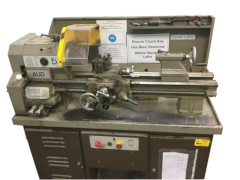
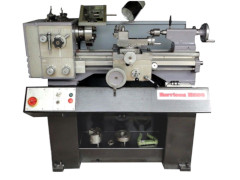
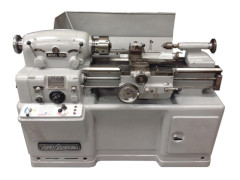
Click On Image To Magnify
Buying any lathe second hand can be a bit of an adventure. It doesn′t really matter where you buy from, dealer, private sale, Ebay or auction provided you are careful. If you′re lucky the lathe will have had little use and have been lovingly cared for. On the other hand the lathe might have come from a jobbing workshop where it has had lots of use and abuse, never been maintained and is on it′s last legs. Then of course there is the chap on Ebay that sells used machinery, never used a machine in his life but can tell a good story and is a dab hand with a paint brush or spray gun! Private sales, auctions and Ebay come with no useful warranty, very much a case of "Caveat Emptor". Check your purchase carefully before parting with any cash. Inspect, test and run everything you possibly can. Go with a friend or better an expert to view the machine. Don′t forget that if you buy at auction there will be fees and VAT on top of the hammer price and you may well be expected to remove your purchase on the day.
A good small lathe which are still quite common is the Boxford AUD. Shown at (12) above this example is from a school and will probably have had fairly light use. You can still see the safety stickers and notices plastered over the machine. Ex school and college machines are often a good buy as they will have had light use but have a good look to make sure the carriage has not been crashed into the headstock by a student! The Boxford AUD was last made around 1976 and is a 250mm (10") swing lathe. The motor is in the cabinet and drives the spindle via a belt and 5 step pulley. Remember that many ex educational lathes will have 3-phase electrics and motor so to work in a domestic environment will either need a new motor and controls or be fitted with a VFD (Variable Frequency Drive). Boxford made many lathes and some of their newer slightly larger offerings like the TS 10.20 would be a good candidate for a home workshop. Have a look at lathes.co.uk Boxford page for an idea what they made.
I think if I were to re-equip I would give serious consideration to the Harrison M250 as shown at (13). This is not quite as common as it's big brother the M300 but was designed for educational and light production work. This lathe is a bit heavier than the Boxford weighing in at around the 370kg mark. It has a 3 D1 camlock nose on the spindle and was also made in a long bed version. Again you would be unlikely to find this lathe with single phase electrics but it's power requirements are modest the original only having around a 1kW motor. Harrison still make the M300 lathe so you could splash out and get a new one. Harrison, Colchester and Clausing are now part of the 600 group.
The last machine in this group (14) is a Smart & Brown 1024 Precision Toolroom Lathe. You may have come across the "toolroom" description whilst looking at other lathes, it generally refers to a machine that has been finished to a high standard of accuracy and is of somewhat heavier construction than it′s counterparts, designed as it′s name suggests to make tooling. The 1024 is no exception weighing in at around the 1200kg mark despite being only 250mm (10") swing. The bed is very wide compared to other lathes affording good stability to the carriage and the cabinet stand is cast iron which is where some of the weight comes from. To a certain extent the heavier the lathe the more rigid and less prone to vibration it is helping to achieve a fine finish. Weight also tends to impart stiffness which helps with repeatability and accuracy. The later versions of this lathe had variable speed drive. The image is from lathes.co.uk have a look for more information. If you can find a good one your workshop will be able to "turn" out top grade work in perpetuity.
To complete the lathes section a trio of machines that might be of interest depending upon your needs, available space and funds. First at (15) is the Myford Super 7 Connoisseur lathe. This is a new build lathe from the "new" Myford (RDG), it is the standard 90mm (3½") centre height with 475mm (19") between centres. The lathe comes with both variable speed motor (VFD in the box on the front), multi speed pulleys and backgear. Spindle taper is 4MT with 26mm bore. Quick change gear box for screw cutting and power cross-feed. This lathe will set you back £9780 at the moment (2019) I assume the cabinet stand is included, the manufacturers write up does say that the lathe can be supplied for bench mounting or with the stand. I think that's a lot of cash for this particular lathe but I have not used this model so what do I know!
If you fancy learning about CNC (Computer Numeric Control) then the Denford MicroTurn may be of interest. This is a current model but there are plenty of small CNC lathes available in the used marketplace. The older types have mainly been released from schools and colleges and are quite likely to come with obsolete software. You can see from the picture that the lathe is of the slant bed type quite common on automatic machines. The slant bed makes for easier part loading and better chip removal from the cutting area. MYCNCUK has a forum for lathe users and plenty of other CNC related information.
Last at (17) is one of the combination lathe / milling machines. This one from Clarke is the CL500M with 305mm swing and 430mm between centres with a milling capacity of 300mm over the table (cross-slide). The machine has a footprint of 1100mm x 600mm x 880mm (LxDxH) so might be what you need if pushed for space. I have never owned or used one of these machines so can give no first hand guidance but I have read that the milling capabilities are somewhat limited by lack of rigidity.You can see from the picture that what would be the column in a milling machine basically has a large hole through it to take the lathe spindle. You can also see that on this particular model there is no carriage handwheel, you have to wind the carriage left to right using the lead-screw handwheel. Another thing to be aware of is the height of the machine, with the lathe bed at a normal height the top of the mill head is a long way up. If you set the machine on a lower bench you may end up stooping somewhat to operate the lathe. There are bigger versions of this type of machine for example the Chester Centurion 3 in 1 machine which although with a similar footprint has a 420mm swing with 500mm between centres.
Lathe Tooling
Your nice new lathe unfortunately won′t be able to do much without some extra bits and pieces. You may have received some tooling with the machine but you will definitely need more! Most important probably is something to hold the work and something to cut it with.
Image (18) shows various lathe chucks for Sieg machines from Arceurotrade, you will however need a chuck to suit your own lathe. You will probably have received at least a 3-jaw chuck with a new machine but fitting a new chuck is not too difficult. You may be able to buy a chuck ready to fit or you may have to machine a backplate that fits between the spindle nose and the chuck. There are three basic types of chuck, self centring, independent jaw and collet. The self centring 3-jaw chuck is most common it should come with two sets of jaws an internal set and an external set. Be aware that each jaw only fits in one location on the chuck, the slots and jaws should be numbered. Self centring chucks also come in 4-jaw and 6-jaw varieties although the 6-jaw is fairly rare and usually expensive. Another chuck commonly supplied with a new lathe is the 4-jaw independent chuck. Each jaw on this type of chuck can be adjusted individually, this means that the chuck can be used to hold square, rectangular and odd shapes such as castings. It is also possible to centre round bars very accurately in the 4-jaw chuck. A normal 3-jaw chuck will only be accurate to within about 0.1mm (0.004") unless you have a "Griptru" chuck where the runout can be adjusted from the backplate.
The collet chuck shown with a single collet in image (18) is of the ER (DIN 6499) type. Apparently the most used collet type despite only being created in 1973 by Rego-Fix (the "E" in ER is a left-over from a previous style of collet and the "R" is for Rego-Fix). There are several different size ranges from ER-8 to ER-50 with different numbers of collets in a complete set. Most useful for the smaller lathe is ER-25 (18 collets, 1mm to 16mm) or ER-32 (21 collets, 1.5mm to 20mm). The ER collets were designed for holding milling cutters and if you have a small milling machine an ER collet chuck is indispensable, get the same size as the lathe and you can share collets between the machines. Imperial sized ER collets are also available if you work extensively with imperial stock or cutters. ER collets unlike others have a 1mm clamping range so the number of collets needed is much less than say morse taper, R8 or 5C collets where each collet is one size only.
Last in image (18) is the faceplate. You may get one of these with a new lathe and they can be useful for mounting odd shaped workpieces, castings for example, or flat plates. I have only used my faceplate a couple of times and if you don′t have one already I wouldn′t bother too much until you have a specific need. The large hole at the centre of the faceplate allows a centre to be fitted in the spindle taper so the faceplate can be used as a catch-plate or drive-plate with work between centres.
To do any work on the lathe you will need some cutting tools. You are unlikely to receive anything useful with a new lathe but a used machine might have something useable. I would steer clear of sets of cutting tools you may get a couple of useful ones but the rest will be little used, ask me how I know this. If you can, buy good quality tools, Sumitomo, Korloy, Sandvik Coromant perhaps. Top left of image (19) are some pre-ground HSS toolbits probably a good place to start if you have never done any turning before. HSS (high speed steel) is an alloy containing iron and commonly chromium, vanadium, silicon and molybdenum among other elements. Specific alloys have different properties but all are tougher and retain a cutting edge at higher temperatures than plain carbon steel. The best way to use HSS is to purchase tool blanks usually square or round 50mm to 80mm long at a size to suit the lathe, 9mm (⅜") is a common size. Grinding the cutting edge to shape is a reasonably straightforward task using a standard bench grinder, have a look at this Tool Grinding Video if you want make your own HSS toolbits. The group of 3 brazed carbide tip tools, bottom left (19), are not as common as they used to be but you may be "given" a set with a new lathe. Unfortunately they are likely to be of poor quality, cut poorly and chip easily. There are better quality brazed tip tools about but these are often supplied unsharpened and you will need a green grit or diamond wheel for your grinder to make them useable. I think the general advice might be to avoid.
Today industry predominantly uses insert lathe tools and these are very good in the home workshop provided you select the right one, not quite so easy given the thousands of possibilities. There are different types of insert, carbide (tungsten carbide), CBN (cubic boron nitride), PCD (poly-crystalline diamond) and lately CerMet which is a ceramic and metal composite. A good place to start might be with a fairly standard right hand tool, top centre (19), from JB Cutting Tools that uses an 80° rhombic CCMT or CCGT insert. The insert codes are many and varied describing the shape, size, tip radius and other parameters, Mitsubishi have a useful page on Insert Codes to help identify and choose cutting inserts.
Inserts are not only for standard cutting tools but are also used in boring bars and parting tools as shown in image (19). Also shown is a boring bar using an HSS toolbit, you can adjust the length and tool angle by sliding the bar in the square split block which is clamped in the toolpost. Lastly in this image is a cranked toolbit holder which used to be common but I don't think are used much these days you may come across one with an older lathe using a single toolpost. One final thing about lathe tools you may already have noticed is that toolbits or holders are described as left or right handed. For some inexplicable reason a tool that cuts towards the headstock is a right-hand tool and one that cuts towards the tailstock left-handed. You will come across web pages that understandably get this wrong. Check with the supplier to make sure it cuts the way you want!
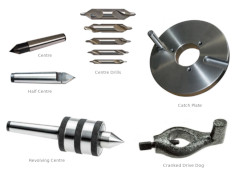
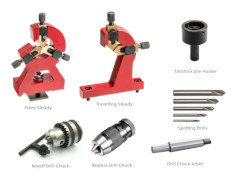
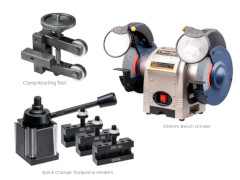
Click On Image To Magnify
Chucks and cutting bits are the most important things you will need for your new lathe but there are plenty of other necessities to help grow your tool collection. Don't try and get everything at once though just add slowly as needed. The next set of images show just a few useful extras that you may need. Please note that the items shown are not necessarily at the same scale.
For turning long pieces of work you may well need to work between centres and image (20) shows the tooling needed for this. Two centres are needed, one to fit the spindle taper and one to fit the tailstock. The "point" of the centre is normally ground at 60° and this fits into a shaped hole in the workpiece created with a centre drill, drills come in a range of sizes. The work is held between the centres using pressure applied by the tailstock barrel. Several types of centre are shown the most common being that at top left. Just below that is a half centre, useful for getting close to small diameter work near the tailstock. If the centre goes round with the spindle it is a live centre and may be unhardened, if it does not rotate at the tailstock it is a dead centre and normally hardened, carbide tipped centres are also available. The dead centre is lubricated in use with grease or tallow. Instead of a dead centre for the tailstock you could use a revolving centre which avoids lubrication problems. The work piece is turned by using a drive dog or carrier to impart rotation, a cranked version can be seen lower right. The dog is clamped to the workpiece and driven by catch/drive plate or faceplate. The catch plate shown has a slot to drive the cranked dog and a pin to drive a straight dog. Don′t leave centres in the tailstock when not in use, the points are really sharp!
When turning long or thin section items whether between centres or using a chuck you may need to use a steady as seen in image (21). These will likely come as accessories with a new lathe but can be made or bought for an older lathe. The fixed steady is clamped to the bed and the three support legs, bronze or roller, are adjusted to support the piece as it rotates. The fixed steady is useful if you have to work on the end of a long bar that won′t pass through the spindle. The travelling steady is bolted to the carriage and the two supports adjusted to be directly opposed to the toolbit. This arrangement allows for thin rods to be turned without flexing. I have also shown two drill chucks, one key operated and one keyless together with an arbor that should suit the tailstock taper. You could of course use the drill chuck from your drilling machine but extracting it from the drill spindle is a bit of a fiddle. Check when you choose an arbor that it will work with the tailstock, some self-extracting tailstocks can lose about 15mm of travel if the arbor has a tang. Make sure also that the arbor isn′t threaded for a drawbar. Another tailstock accessory you may need for cutting smaller threads onto a bar is the tailstock die holder. The one shown is held in a drill chuck. The remaining items in this image are spot drills these are short and stiff with little flute and come to a sharp point designed for starting a hole. Many people (including me) use a centre drill to start a hole but small centre drills are easily broken if the end of the bar isn′t as smooth as it should be or has a centre pip. The correct tool for hole starting is the spot drill, which of course can be used in the mill or drilling machine.
The final image (22) shows a clamp type knurling tool which is useful to have for making knobs and lock screws and the like. The clamp action takes the strain off the spindle bearings and cross-slide lead-screw. You can get push in knurling tools which really need a larger lathe and best of all is the cut knurling tool but these are a bit pricey. I have also shown a Quick Change Toolpost (QCTP) and holders that you may wish to upgrade to eventually. This is a Chinese clone of an Aloris style toolpost with a wedge action from ArcEuroTrade it comes with three standard tool holders. I suggest avoiding the sets that come with five different holders, not all the holders are useful. There are other designs of QCTP - Dickson, Multifix and Tripan each with their own range of clones and of course you can make your own. The last item in image (22) is a small bench grinder. Not a lathe accessory but a useful tool in it′s own right. You will need one if you are going to grind your own HSS tools. Can of course be use to sharpen drills, de-burr stock bar and a myriad of other workshop tasks.
Further Reading
- Suppliers
- ArcEuroTrade - Sieg Lathes
- Amadeal - Lathes range
- Chester - Lathes range
- Axminster - Lathes range
- Proxxon - Lathes & Mills
- Cowells - 90ME Lathe
- Warco - Model Engineering Lathes
- Rondean Machinery - Used Machinery dealer
- G&M Tools - Used Machinery Dealer Websites
- Journeyman′s Workshop - Lathe & Mill Glossary
- Lathes.co.uk - Metal Lathes, A Beginners Guide To Selecting And Buying
- Axminster Power Tools - Buying Your First Engineering Lathe
- Mini-Lathe.Com - Frank Hoose has loads of information on mini-lathe projects and mods.
- Adept Mini-Lathe - Andrew Webster has an intersting look at a very old mini-lathe.
- Lathework For Beginners - This is a thread on the Model Engineer Forum, it supports a series in Model Engineers Workshop magazine. Books
- The Mini-Lathe - Neil Wyatt (Model Engineers Workshop editor) gives information on buying, running and modifying.
- The Mini-Lathe - One of the "Workshop Practice" series by David Fenner
- Mini-Lathe Tools & Projects for Home Machinists - Again by David Fenner details useful additions for the lathe.
- Lathework A Complete Course - Another book in the "Workshop Practice" series by Harold Hall.
- Myford Series 7 Manual - Ian Bradley's classic guide to using Myford 7 series, revised 1980.
- Lathework For Beginners - A new book by Neil Wyatt (2020) based on a series in Model Engineers Workshop magazine
